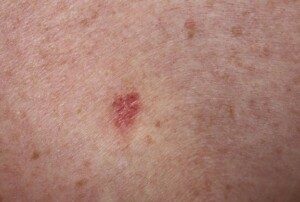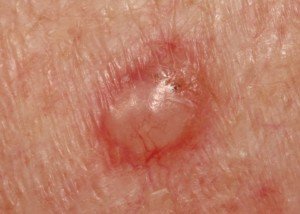Basal cell carcinoma is the most common cancer in the world.
Just how many basal cell carcinomas can show up at the same time?
BCC is directly linked to sun exposure and typically shows up in areas that have received long-term exposure to the sun – particularly the nose and other parts of the face.
It affects all races, though Caucasians are at highest risk.
Though this malignancy is extremely slow growing and is rarely fatal, this disease should not be taken lightly.
Death from BCC is strongly associated with elderly age and not having the lesion checked out by a doctor, allowing it to grow over many years until it eventually metastasizes.
People who live in poverty in rural areas or in developing countries are more likely to neglect getting the growing lesion on their face, eyelid, ear, lip or elsewhere checked by a medical professional.
Neglect of a BCC will allow it to cause local destruction of tissue which can include bone.
The disfigurement from this can be quite extensive.

Early BCC. National Cancer Institute
How many basal cell carcinomas can you get at the same time?
“You can get many basal cell carcinomas at once in different parts of the body,” says Cameron K. Rokhsar, MD, a double board-certified dermatologist and owner of New York Cosmetic, Skin & Laser Surgery Center.
“This usually occurs in sun damaged individuals who have failed to be examined by a board certified dermatologist on a regular basis.
“Having one basal cell carcinoma increases your chances of developing other ones in the future.”
Though neglecting to get the lesion examined is more likely to occur in uneducated people who don’t have easy access to medical care, this does not mean that highly educated people with money will make an appointment with a dermatologist upon realizing that “the bump” or “the pink patch” isn’t going away.
My brother is an example. He had a college degree, a professional job, made good money and had a healthcare plan.
He’d always wondered what the dime sized spot on his forehead was. It didn’t itch, sting, ooze, crust or bleed, so he wasn’t worried about it.
But finally, after five years, he decided to get it examined. At that point, it was still dime sized and rather flat.
Of course, it turned out to be a basal cell carcinoma, and it was treated via Mohs micrographic surgery.
Though the tumor was dime sized, this doesn’t mean the excisional area wasn’t much larger than a dime.
He told me that the stitching on his forehead “looked like Frankenstein.” However, the scarring healed nicely and eventually was hardly noticeable.
Any lesions on your body that don’t go away after two weeks should be checked out.
However, a stubborn bump, blemish or patch isn’t always cancer.
For example, it’s common for people over 40 to develop seborrheic keratoses – harmless skin overgrowths.

Seborrheic keratoses. Shutterstock/Dhujmontra
But at least you should get the diagnosis rather than continuing to wonder “what it could be,” especially if you have multiple such lesions on your face.
There is no data on the most number of basal cell carcinomas that any particular patient ever had simultaneously.
 At New York Cosmetic, Skin, and Laser Surgery Center, Cameron K. Rokhsar, MD, FAAD, FAACS, and his team provide exceptional skin care solutions for many conditions and skin diseases including all types of skin cancer. Dr. Rokhsar is board certified in dermatology and dermatologic surgery.
At New York Cosmetic, Skin, and Laser Surgery Center, Cameron K. Rokhsar, MD, FAAD, FAACS, and his team provide exceptional skin care solutions for many conditions and skin diseases including all types of skin cancer. Dr. Rokhsar is board certified in dermatology and dermatologic surgery.
 Lorra Garrick has been covering medical, fitness and cybersecurity topics for many years, having written thousands of articles for print magazines and websites, including as a ghostwriter. She’s also a former ACE-certified personal trainer.
Lorra Garrick has been covering medical, fitness and cybersecurity topics for many years, having written thousands of articles for print magazines and websites, including as a ghostwriter. She’s also a former ACE-certified personal trainer.
.



























